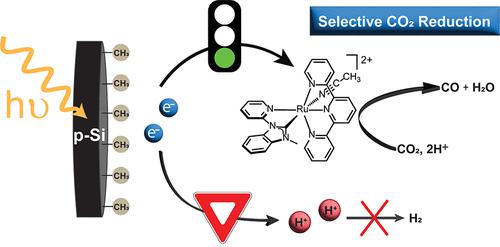当前位置:
X-MOL 学术
›
ACS Energy Lett.
›
论文详情
Our official English website, www.x-mol.net, welcomes your feedback! (Note: you will need to create a separate account there.)
Methyl Termination of p-Type Silicon Enables Selective Photoelectrochemical CO2 Reduction by a Molecular Ruthenium Catalyst
ACS Energy Letters ( IF 22.0 ) Pub Date : 2024-03-27 , DOI: 10.1021/acsenergylett.4c00122 Gabriella P. Bein 1 , Madison A. Stewart 1 , Eric A. Assaf 1 , Stephen J. Tereniak 1 , Renato N. Sampaio 1 , Alexander J. M. Miller 1 , Jillian L. Dempsey 1
ACS Energy Letters ( IF 22.0 ) Pub Date : 2024-03-27 , DOI: 10.1021/acsenergylett.4c00122 Gabriella P. Bein 1 , Madison A. Stewart 1 , Eric A. Assaf 1 , Stephen J. Tereniak 1 , Renato N. Sampaio 1 , Alexander J. M. Miller 1 , Jillian L. Dempsey 1
Affiliation

|
Methyl-terminated p-type silicon photoelectrodes selectively drive CO2 reduction by a homogeneous [Ru(tpy)(Mebim-py)(NCCH3)]2+ catalyst (tpy = 2,2′:6′,2″-terpyridine, Mebim-py = 1-methylbenzimidazol-2-ylidene-3-(2′-pyridine)). A 460 mV photovoltage is quantified for the photoelectrode. Under 1 sun illumination, this system achieves a Faradaic efficiency of 87% for CO at −1.7 V vs Fc+/0, matching reports of the same catalyst at metallic electrodes operating at −2.1 V. When 5% water is introduced, the CH3-terminated Si photoelectrode remains stable, selectivity for CO is retained, and current density increases. Methyl termination suppresses the competitive hydrogen evolution observed for H-terminated Si photoelectrodes, which under the same conditions produce ca. 60% CO and 8% H2 and have unstable performance. These results establish that a semiconductor photoelectrode can power a molecular CO2 reduction catalyst without hydrogen evolution by the photoelectrode itself. Methyl termination of p-Si allows CO2 reduction to kinetically outcompete proton reduction, revealing an important design principle for selective fuel formation.
中文翻译:

p 型硅的甲基封端使得钌分子催化剂能够选择性光电化学 CO2 还原
甲基封端的p型硅光电极通过均相[Ru(tpy)(Mebim-py)(NCCH 3 )] 2+催化剂(tpy = 2,2′:6′,2″-三联吡啶,选择性地驱动CO 2还原, Mebim-py = 1-甲基苯并咪唑-2-亚基-3-(2′-吡啶))。光电极的光电压为 460 mV。在 1 个太阳光照下,该系统在 −1.7 V vs Fc +/0下实现了 87% 的 CO 法拉第效率,与在 −2.1 V 下运行的金属电极上相同催化剂的报告相匹配。当引入 5% 的水时,CH 3-封端Si光电极保持稳定,对CO的选择性得以保留,并且电流密度增加。甲基末端抑制了氢末端硅光电极观察到的竞争性析氢,在相同条件下产生约60%CO和8%H 2,性能不稳定。这些结果证实半导体光电极可以为分子CO 2还原催化剂提供动力,而光电极本身不会析出氢气。 p-Si 的甲基末端使得 CO 2还原在动力学上胜过质子还原,揭示了选择性燃料形成的重要设计原理。
更新日期:2024-03-27
中文翻译:

p 型硅的甲基封端使得钌分子催化剂能够选择性光电化学 CO2 还原
甲基封端的p型硅光电极通过均相[Ru(tpy)(Mebim-py)(NCCH 3 )] 2+催化剂(tpy = 2,2′:6′,2″-三联吡啶,选择性地驱动CO 2还原, Mebim-py = 1-甲基苯并咪唑-2-亚基-3-(2′-吡啶))。光电极的光电压为 460 mV。在 1 个太阳光照下,该系统在 −1.7 V vs Fc +/0下实现了 87% 的 CO 法拉第效率,与在 −2.1 V 下运行的金属电极上相同催化剂的报告相匹配。当引入 5% 的水时,CH 3-封端Si光电极保持稳定,对CO的选择性得以保留,并且电流密度增加。甲基末端抑制了氢末端硅光电极观察到的竞争性析氢,在相同条件下产生约60%CO和8%H 2,性能不稳定。这些结果证实半导体光电极可以为分子CO 2还原催化剂提供动力,而光电极本身不会析出氢气。 p-Si 的甲基末端使得 CO 2还原在动力学上胜过质子还原,揭示了选择性燃料形成的重要设计原理。



























 京公网安备 11010802027423号
京公网安备 11010802027423号